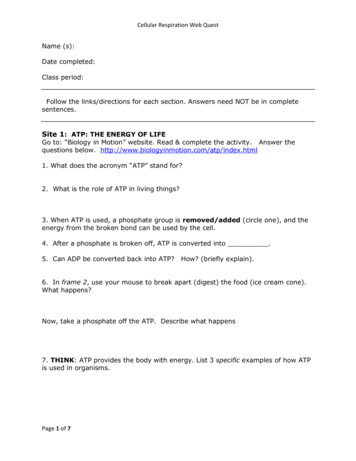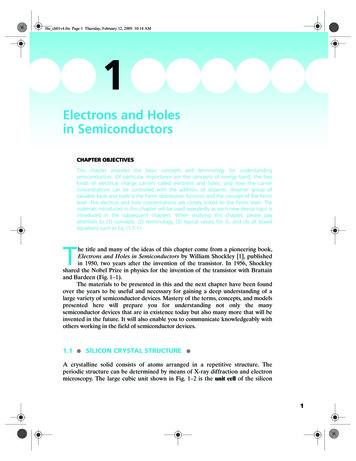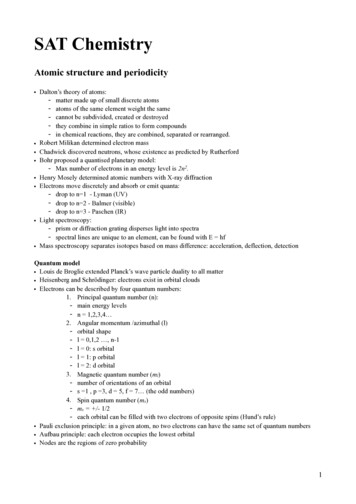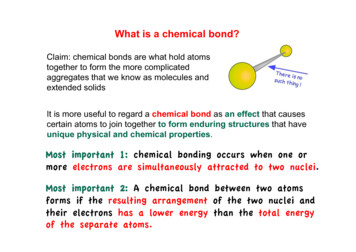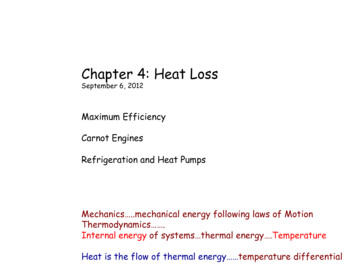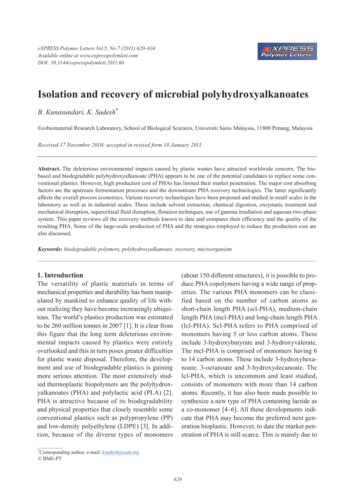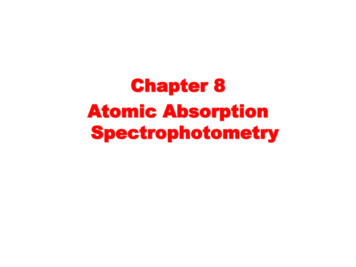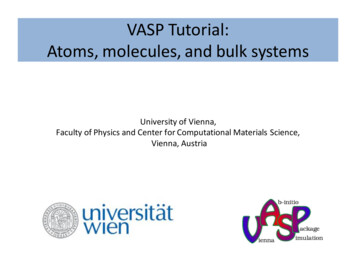
Transcription
VASP Tutorial:Atoms, molecules, and bulk systemsUniversity of Vienna,Faculty of Physics and Center for Computational Materials Science,Vienna, Austria
Setting up a VASP calculationVASP requires 4 input files to run a calculation: INCARPOSCARKPOINTSPOTCAR
I: The INCAR fileThe INCAR file contains the input parameters that steer the calculation: The default values set by VASP itself are a clever choice for moststandard calculations These standard settings may be modified to specify: What kind of calculation you want to do:SCF calculation, DOS, dielectric properties, Basic inputs concering the required precision, the requestedlevel of convergence, .For a list of all INCAR-tags have a look at: The VASP manual: ex: http://cms.mpi.univie.ac.at/vasp/vasp/Index.html The VASP wiki: http://cms.mpi.univie.ac.at/wiki/index.php/Main pageINCAR-tags: y:INCAR
II: The POSCAR fileIn the POSCAR file you specify the structure (Bravais lattice and basis):fcc: NiHeader (comment)3.53Overall scaling constant0.5 0.5 0.00.0 0.5 0.50.5 0.0 0.5Bravais matrixNiName(s) of atomic type(s)1Number of atoms (of each type)Selective Dynamics(optional: selective dynamics)CartesianCartesian or Direct coordinates0 0 0 (T T T)positions of the atoms
III: The KPOINTS fileIn the KPOINTS file you specify the points VASP will use to sample thefirst Brillouin zone in reciprocal spaceAutomatic meshHeader (comment)0Nk 0: automatic mesh generationG (M)𝝘-centered (G) mesh or Monkhorst-Pack (M) grid4440. 0. 0.# of subdivisions 𝑁𝑖 along 𝑏Ԧ𝑖Optionally shift the mesh (𝑠𝑖 )
IV: The POTCAR fileThe POTCAR file has to contain the PAW datasets for all atomic types you havespecified in your POSCAR file:VASP comes with a library of PAW datasets, (one or more) for most elements of theperiodic table: Each individual PAW data set starts with a descriptive section, specifyingamongst other things: Parameters that were required to generate the dataset: Number of valence electrons Atomic mass Default energy cutoffs When your unit cell contains more than one type of atom you have toconcatenate the corresponding PAW datasets in the same order as you havespecified the different atomic types in your POSCAR file. You should not mix PAW datasets generated with different exchange-correlationfunctionals.
OUTPUT filesOUTCAR detailed output of a VASP run, including: a summary of the input parameters information about the individual electronic steps:total energy, Kohn-Sham eigenvalues, Fermi-energy. stress tensors forces in the atoms local charges, magnetic moments dielectric properties . and a great many things more .The amount of output written onto OUTCAR can be chosen bymeans of the NWRITE-tag in the INCAR file.OSZICAR & stdout give a short summary of the self-consistency-cycle chosen SCF algorithm convergence of energy and charge density free energies, total magnetic moment of the cell
OUTPUT filesCONTCAR & XDATCAR CONTCAR: updated geometry data at the end of a run lattice parameter Bravais matrix ionic positions velocitiesthe format of the CONTCAR is the same as for POSCAR:It can be directly be used for a continuation run (copyCONTCAR to POSCAR)XDATCAR: updated ionic positions of each ionic stepDOSCAR, CHGCAR & WAVECAR DOSCAR: total DOS and integrated DOS, (local partial DOS)CHGCAR: the charge densityWAVECAR: plane wave coefficients of the orbitals.Can be used to restart from a previous run
Atoms and MoleculesExamples: O atom O2 dimer CO H2OTasks: Single point total energy Relaxation Vibrational frequencies MD
The oxygen atom (ex.: O atom)The POSCAR file specifies the Bravais lattice (lattice vectors) and basis (atomicpositions). In this case, a single atom in a box:O atom in a boxHeader (comment)1.0Overall scaling constant8.0 0.0 0.00.0 8.0 0.00.0 0.0 8.0lattice vector a(1)lattice vector a(2)lattice vector a(3)1Number of atomscartPositions in cartesian coordinates0 0 0positions of atom 1The INCAR file steers the calculationSYTEM O atom in a boxName of the calculationISMEAR 0Selects Gaussian smearing
The oxygen atom (ex.: O atom)The KPOINTS file determines which Bloch wave vectors 𝑘 are used to samplethe first Brillouin zone. For atoms or molecules only a single k-point is used: 𝑘 0 (the 𝝘-point) Were more/other k-points to be used, only the interaction between theperiodically repeated images of the atom or molecule, that we’d like to be zero,are described moreaccurately.The KPOINTS file:Gamma-point onlyHeader (comment)0Nk 0: automatic mesh generationMonkhorst-PackMonkhorst-Pack grid1# of subdivisions 𝑁𝑖 along 𝑏Ԧ𝑖110. 0. 0.Optionally shift the mesh (𝑠𝑖 )
The oxygen atom (ex.: O atom)Running VASP should yield the following on stdout (and much the same on OSZICAR):running on8 total coresdistrk: each k-point on8 cores,1 groupsdistr: one band on1 cores,8 groupsusing from now: INCARvasp.5.4.1 05Feb16 (build Aug 22 2016 16:46:23) complexPOSCAR found : 1 types and1 ionsscaLAPACK will be usedLDA part: xc-table for Pade appr. of PerdewPOSCAR, INCAR and KPOINTS ok, starting setupWARNING: small aliasing (wrap around) errors must be expectedFFT: planning .WAVECAR not readentering main loopNEdEd epsDAV:10.384469664751E 020.38447E 02-0.96726E 02DAV:20.345965628955E 01-0.34987E 02-0.34942E 02DAV:3-0.244485866931E 00-0.37041E 01-0.34307E 01DAV:4-0.312557021227E 00-0.68071E-01-0.66914E-01DAV:5-0.313520305300E 00-0.96328E-03-0.96311E-03DAV:6-0.314540466589E 00-0.10202E-02-0.17853E-03DAV:7-0.314637222361E 00-0.96756E-04-0.22710E-041 F -.31463722E 00 E0 -.16037490E 00 d E -.308525E 00writing wavefunctionsncg16321616321616rms0.293E 020.450E 010.308E 010.508E -01
The oxygen atom (ex.: O atom)entering main loopNEdEd epsDAV:10.384469664751E 020.38447E 02-0.96726E 02DAV:20.345965628955E 01-0.34987E 02-0.34942E 02DAV:3-0.244485866931E 00-0.37041E 01-0.34307E 01DAV:4-0.312557021227E 00-0.68071E-01-0.66914E-01DAV:5-0.313520305300E 00-0.96328E-03-0.96311E-03DAV:6-0.314540466589E 00-0.10202E-02-0.17853E-03DAV:7-0.314637222361E 00-0.96756E-04-0.22710E-041 F -.31463722E 00 E0 -.16037490E 00 d E -.308525E 00writing wavefunctionsncg16321616321616rms0.293E 020.450E 010.308E 010.508E -01OSZICAR and stdoutNIteration countETotal energydEChange of total energyd epsChange in the eigenvalues (at fixed potential)ncgNumber of times 𝐻𝜓 is evaluated (essential part ofoptimization)rmsTotal residual vector σ𝑛𝑘 𝑤𝑘 𝑓𝑛𝑘 𝐻 𝜀𝑛𝑘 𝜓𝑛𝑘rms(c)Charge-density residual vector The initial charge density corresponds to the charge of overlapping atomiccharge densities (from the POTCAR file). For 4 steps the charge density waskept fixed, thereafter it was updated (see the rms(c) column).
The oxygen atom (ex.: O atom)The main output of VASP is written to the OUTCAR file. It contains several section,separated by lines like the ------------------The sections are: first part: reading INCAR, POTCAR, POSCARnearest neighbor distances and analysis of symmetryinformation on what was parsed from INCARverbose job informationinformation on lattice, k-points and positionsinformation on the basis set (number of plane waves)non local pseudopotential informationinformation for each electronic step (one line in OSZICAR)
The oxygen atom (ex.: O atom) Timing and energy information:POTLOK: cpu time0.0878: real time0.0877SETDIJ: cpu time0.0015: real time0.0014EDDAV: cpu time0.0267: real time0.0434DOS: cpu time0.0001: real ---LOOP: cpu time0.1165: real time0.1346eigenvalue-minimisations :16total energy-change (2. order) : 0.3844697E 02 (-0.9672571E 02)number of electron6.0000000 magnetizationaugmentation part6.0000000 magnetizationFree energy of the ion-electron system ----alpha ZPSCENC 0.27135287Ewald energyTEWEN -91.92708002-Hartree energ DENC -281.84385691-exchangeEXHF 0.00000000-V(xc) E(xc)XCENC 26.11948841PAW double counting 245.99840262-247.84808825entropy T*SEENTRO -0.08636665eigenvaluesEBANDS -44.50008162atomic energy EATOM 432.26319604Solvation Ediel sol ----------free energyTOTEN 38.44696648 eVenergy without entropy 38.53333313energy(sigma- 0) 38.49014980
The oxygen atom (ex.: O atom) Eigenvalues:E-fermi :k-pointband No.12345678-8.8431XC(G 0):-0.80431 :0.00000.0000band 001.86330.000001.86330.00000alpha bet : -0.14630.0000
The oxygen atom (ex.: O atom) Information on stress tensor:FORCE on cell -STRESS in cart. coord. units -----------Alpha 1 -147.86211 746810.00000-0.00000-0.00000in xternal pressure -2.34 kB Pullay stress 0.00 kB and energy:FREE ENERGIE OF THE ION-ELECTRON SYSTEM ----free energyTOTEN -0.31463722 eVenergywithout entropy -0.00611258energy(sigma- 0) -0.16037490
The oxygen atom (ex.: O atom) the relevant energy for atoms and molecules is energy without entropy:energywithout entropy -0.00611258energy(sigma- 0) -0.16037490three degenerate p orbitals occupied by 2/3 electrons causing a unphysicalelectronic entropyentropy T*SEENTRO -0.30852464 a tiny value for SIGMA 0.01 would reduce the entropy but might slowconvergence (default is SIGMA 0.2).SIGMA controls the electronic temperature, which is not a very meaningfulquantity for atoms and molecules. the total energy is found to be essentially zero:VASP subtracts from any calculated energy the energy of the atom in theconfiguration for which the PAW dataset was generated.All PAW datasets are generated using non-spinpolarized reference atoms.
The oxygen atom (ex.: O atom)running on8 total coresdistrk: each k-point on8 cores,1 groupsdistr: one band on1 cores,8 groupsusing from now: INCARvasp.5.4.1 05Feb16 (build Aug 22 2016 16:46:23) complexPOSCAR found : 1 types and1 ionsscaLAPACK will be usedLDA part: xc-table for Pade appr. of Perdewfound WAVECAR, reading the headerPOSCAR, INCAR and KPOINTS ok, starting setupWARNING: small aliasing (wrap around) errors must be expectedFFT: planning .reading WAVECARthe WAVECAR file was read successfullyinitial charge from wavefunctionentering main loopNEdEd epsDAV:1-0.314680766875E 00-0.31468E 00-0.83090E-05DAV:2-0.314677281013E 000.34859E-05-0.10030E-051 F -.31467728E 00 E0 -.16041496E 00 d E -.308525E 00writing wavefunctions ncg1616rms0.564E-020.198E-02rms(c)0.107E-02When VASP is restarted the WAVECAR file is read and the run continues fromthe previous wavefunctions (converging rapidly).
The O atom (ex.: O atomspin) The O atom is an open-shell system with 2 unpaired electrons.add ISPIN 2 to the INCAR file, remove the WAVECAR file, and restart VASP:running on8 total coresdistrk: each k-point on8 cores,1 groupsdistr: one band on1 cores,8 groupsusing from now: INCARvasp.5.4.1 05Feb16 (build Aug 22 2016 16:46:23) complexPOSCAR found : 1 types and1 ionsscaLAPACK will be usedLDA part: xc-table for Pade appr. of PerdewPOSCAR, INCAR and KPOINTS ok, starting setupWARNING: small aliasing (wrap around) errors must be expectedFFT: planning .WAVECAR not readentering main loopNEdEd epsncgDAV:10.389725012498E 020.38973E 02-0.10098E 0332DAV:20.317912429240E 01-0.35793E 02-0.35786E 0264DAV:3-0.119085682530E 01-0.43700E 01-0.36686E 0132DAV:4-0.126198272139E 01-0.71126E-01-0.69189E-0132DAV:5-0.126284205021E 01-0.85933E-03-0.85925E-0348DAV:60.164008071667E 000.14269E 01-0.32208E 0032 DAV: 13-0.167302579657E 01-0.25698E-03-0.13177E-0532DAV: 14-0.167302926747E 01-0.34709E-05-0.34771E-06321 F -.16730293E 01 E0 -.15958981E 01 d E -.154262E 00 mag writing wavefunctionsrms0.259E 020.438E 010.328E 010.508E 000.504E-010.894E 000.203E-020.116E-021.9999rms(c)0.653E 000.151E 000.956E-03
The spinpolarized O atom (ex.: O atomspin)E-fermi :-7.1152XC(G 0):-0.7730alpha bet : -0.1463spin component 1k-pointband No.123456781 :0.00000.0000band 000001.83030.000001.83030.000000.0000 Eigenstates for spin-up and spin-downare calculated ”separately”. In the OUTCAR file one can see twospin components Spincomponent “1” has 2 moreelectrons, corresponding to amagnetization of 2 𝜇𝐵spin component 2k-pointband No.123456781 :0.00000.0000band 001.98300.000001.98300.000000.0000
The O atom (ex.: O atomspinlowsym) In the GGA most atoms are characterized by a symmetry broken solution.VASP, however, symmetrizes the charge density according to the determinedsymmetry of the cell.Check the OUTCAR file to see what symmetry VASP is using.To lower the symmetry simply change the lattice parameters to 7.0, 7.5, and 8.0in the POSCAR file :O atom in a boxHeader (comment)1.0Overall scaling constant7.0 0.0 0.00.0 7.5 0.00.0 0.0 8.0lattice vector a(1)lattice vector a(2)lattice vector a(3)1Number of atomscartPositions in cartesiancoordinates0 0 0positions of atom 1reduce SIGMA to SIGMA 0.01 (in the INCAR file).Rerun VASP, and you will find a much lower energy:vasp.5.4.1 05Feb16 (build Aug 22 2016 16:46:23) complex DAV: 15-0.189071145737E 01-0.29321E-03-0.39183E-0548DAV: 16-0.189098921147E 01-0.27775E-03-0.39294E-0540DAV: 17-0.189104076616E 01-0.51555E-04-0.34087E-06481 F -.18910408E 01 E0 -.18910408E 01 d E -.309633E-20 mag 3
The O2 dimer (ex.: O dimer) POSCAR:O atom in a boxHeader (comment)1.0Overall scaling constant7.0 0.0 0.00.0 7.5 0.00.0 0.0 8.0lattice vector a(1)lattice vector a(2)lattice vector a(3)2Number of atomscartPositions in cartesian coordinates0 0 00 0 1.22first atomsecond atomINCAR: structural relaxation of the O2 dimerSYTEM O2 dimer in a boxISMEAR 0Gaussian smearingISPIN 2spin-polarized calculationNSW 55 ionic stepsIBRION 2use conjugate gradient algorithm
The O2 dimer (ex.: O dimer) We have specified that the geometry should be relaxed: in this case5 ionicsteps (NSW 5) are to be done at most.For the relaxation a conjugate gradient algorithm is used (IBRION 2).CG requires a line minimization along the search direction:x0x1x0x1xtrial 1xtrial 2this is done using a variant of Brent’s algorithm: Trial step along search direction (gradient scaled by POTIM). Quadratic or cubic interpolation using energies and forces at 𝑥Ԧ0 and 𝑥Ԧ1allows to determine the approximate minimum. Continue minimization if app. minimum is not accurate enough.
The O2 dimer (ex.: O dimer)DAV:10.517118590134E 020.51712E 02-0.31393E 03800.366E 02 DAV: 14-0.985349953776E 01-0.15177E-03-0.57546E-06640.125E-020.371E-03DAV: 15-0.985357023804E 01-0.70700E-04-0.22439E-06640.741E-031 F -.98535702E 01 E0 -.98535702E 01 d E -.985357E 01 mag 2.0000curvature:0.00 expect dE 0.000E 00 dE for cont linesearch 0.000E 00trial: gam 0.00000 g(F) 0.113E 00 g(S) 0.000E 00 ort 0.000E 00 (trialstep 0.100E 01)search vector abs. value 0.113E 00bond charge predicted 2 F -.96234585E 01 E0 -.96234585E 01 d E 0.230112E 00 mag 2.0000trial-energy change:0.230112 1 .order0.190722-0.1134060.494850step:0.1397(harm 0.1864) dis 0.00731 next Energy -9.861386 (dE -0.782E-02)bond charge predicted 3 F -.98607735E 01 E0 -.98607735E 01 d E -.720327E-02 mag 2.0000curvature: -0.09 expect dE -0.900E-05 dE for cont linesearch -0.900E-05trial: gam 0.00000 g(F) 0.969E-04 g(S) 0.000E 00 ort -0.331E-02 (trialstep 0.828E 00)search vector abs. value 0.969E-04reached required accuracy - stopping structural energy minimisation
The O2 dimer (ex.: O dimer) The quantity trial-energy change is the change of the energy in the trial step The first value after 1.order is the expected energy change calculated from theforces:𝐹 start 𝐹 trial change of positions2central difference: the second and third values correspond to:𝐹 start change of positions and 𝐹 trial change of positions The value step: is the estimated size of the step leading to a line minimizationalong the current search direction.harm is the optimal step using a second order (or harmonic) interpolation. The trial step size is controlled by the parameter POTIM. The value of step timesPOTIM is usually optimal. The final positions after the optimisation are stored in CONTCAR.You can copy CONTCAR to POSCAR and continue the relaxation.
The CO molecule (ex.: CO) POSCAR:Header (comment)1.0Overall scaling constant8.0 0.0 0.00.0 8.0 0.00.0 0.0 8.0lattice vector a(1)lattice vector a(2)lattice vector a(3)1 1Number of atoms for each speciescartPositions in cartesian coordinates0 0 00 0 1.12first atomsecond atomPOTCAR: is created by the concatenation of two individual POTCAR files,corresponding to O and C, e.g.:cat CO molecule in a box /O/POTCAR./C/POTCAR POTCARA similar relaxation as in the previous case (O2 dimer) is performed.But in this case more steps are required, since the first estimate for theminimum is not very accurate.The trial steps are much too long (POTIM parameter).
The CO molecule (ex.: CO)1 F -.14764064E 02 E0 -.14764064E 02 d E -.147641E 02curvature:0.00 expect dE 0.000E 00 dE for cont linesearch 0.000E 00trial: gam 0.00000 g(F) 0.820E 00 g(S) 0.000E 00 ort 0.000E 00 (trialstep 0.100E 01)search vector abs. value 0.820E 00bond charge predicted 2 F -.12660858E 02 E0 -.12660858E 02 d E 0.210321E 01trial-energy change:2.103205 1 .order1.311207-0.8198733.442288step:0.1924(harm 0.1924) dis 0.02705 next Energy -14.842919 (dE -0.789E-01)bond charge predicted 3 F -.14747869E 02 E0 -.14747869E 02 d E 0.161943E-01curvature: -0.10 expect dE -0.902E-01 dE for cont linesearch -0.902E-01ZBRENT: interpolatingopt :0.0929 next Energy -14.802162 (dE -0.381E-01)bond charge predicted 4 F -.14796822E 02 E0 -.14796822E 02 d E -.327586E-01curvature: -0.04 expect dE -0.330E-03 dE for cont linesearch -0.330E-03trial: gam 0.00000 g(F) 0.814E-02 g(S) 0.000E 00 ort -0.817E-01 (trialstep 0.819E 00)search vector abs. value 0.814E-02reached required accuracy - stopping structural energy minimisation
Vibrational frequencies of CO (ex.: CO vibration) INCAR:POSCAR:SYTEM CO molecule in a boxISMEAR 0Gaussian smearingIBRION 5Vibrational spectrumNFREE 2Use central differencesPOTIM 0.020.02 step widthNSW 1ionic steps must be 1,that’s allCO molecule in a boxHeader (comment)1.0Overall scaling constant8.0 0.0 0.00.0 8.0 0.00.0 0.0 8.0lattice vector a(1)lattice vector a(2)lattice vector a(3)1 1Number of atoms for each speciesselSelective dynamicscartPositions in cartesian coordinates0 0 00 0 1.143FFFFTTfirst atomsecond atomThe selected degrees of freedom are displaced, once in the 𝑧Ƹ and oncein the 𝑧Ƹ direction, by 0.02 Å. In the present case this means 4 displacements,plus the unperturbed geometry (i.e., a total of five ionic configurations).
Vibrational frequencies of CO (ex.: CO vibration) At the end of the OUTCAR file:SECOND DERIVATIVES (NOT Z1Z -114.737304 114.7373042Z114.458316 -114.458316Eigenvectors and eigenvalues of the dynamical -------1 f 63.887522 THz401.417139 2PiTHz 2131.058277 cm-1264.217647 meVXYZdxdydz0.000000 0.000000 0.00000000-0.6552800.000000 0.000000 1.143000000.7553862 f/i 0.038494 THz0.241864 2PiTHzXYZdx0.000000 0.000000 0.00000000.000000 0.000000 1.14300001.284016 cm-10.159198 meVdydz0-0.7553860-0.655280
Eigenstates of CO (ex.: CO states) The PROCAR file gives valuable information on the character of the one-electronstates:LORBIT 10DOSCAR and l-decomposed PROCAR fileLORBIT 11DOSCAR and lm-decomposed PROCAR fileWe’ll use LORBIT 11, and see if we can distinguish 𝑝𝑥 and 𝑝𝑦 states.Look in the PROCAR file:bandion12totbandion12totbandion12tot3 # energys0.0000.0000.000py0.5100.1460.6564 # energys0.0000.0000.000py0.0360.0100.0475 # 2 # 00-11.46540832 # x0.5100.1460.656dxy0.0000.0000.000-8.76483386 # .0000.0000.000dz20.0000.0000.000
Start p4vasp: p4v [vasprun.xml]Step 2.) select atoms: “all”, “C”, ”O”, “1”, “2”, Step 1.) go to:Electronic/Local DOS bands controlStep 3.) select orbital characterStep 4.) and “Add new line”
The H2O molecule (ex.: H2O) POSCAR:H2O moleculeHeader (comment)0.52918Overall scaling constant15.0 0.0 0.00.0 15.0 0.00.0 0.0 15.0lattice vector a(1)lattice vector a(2)lattice vector a(3)1 2Number of atoms per speciesselectcart0.00 0.001.10 -1.431.10 1.43Positions in cartesian coordinates0.000.000.00F F FT T FT T Fall coordinates are scaled by the factor 0.52918 INCAR: structural relaxation of the O2 dimerPREC NormalStandard precisionENMAX 400Cutoff should be set manuallyISMEAR 0 ; SIGMA 0.1IBRION 1Use DIIS algorithm to relax structureNFREE 22 independent degrees of freedomNSW 1010 ionic stepsEDIFFG -0.02Forces smaller 0.02 Angstroem/eV
The H2O molecule(relaxation: H2O, vibrations: H2Ovib) Use PREC Normal (Default for VASP.5.X) It is strongly recommended to set the energy cutoff manually in the INCAR file,as it gives you more control over the calculations and forces you to think aboutthis aspect. For the ionic optimisation the DIIS algorithm is used.This algorithm builds an approximation of the Hessian matrix and usuallyconverges faster than the conjugate gradient algorithm.It is, however, recommended to specify the number of independentdegrees-of-freedom manually.EDIFFG determines when to terminate the ionic relaxation:EDIFFG 0: energy change between steps must be less than EDIFFG.EDIFFG 0: 𝐹Ԧ𝑖 EDIFFG 𝑖 1, , 𝑁ions.
MD with the H2O molecule (ex.: H2Omd) INCAR:PREC NormalStandard precisionENMAX 400Cutoff should be set manuallyISMEAR 0 ; SIGMA 0.1ISYM 0Strongly recommended for MDIBRION 0Molecular DynamicsNSW 10001000 MD stepsPOTIM 0.5Timestep 0.5 fsSMASS -3Nose-Hoover thermostatTEBEG 2000 ; TEEND 2000Temperature (begin, end)NBANDS 8time step for this system should be around 0.5-0.7 fs POSCAR: to save time the box size is reduced to 12 a.u. OSZICAR:1 T 2 T 3 T 4 T 5 T .2134. E 1971. E 1336. E 1011. E 1307. E . . . .-.13655511E 02-.13643254E 02-.13629241E 02-.13624149E 02-.13629772E 02F F F F F -.14207209E 02-.14152912E 02-.13974630E 02-.13885486E 02-.13967549E 02E0 .E0 .E0 .E0 .E0 .EK EK EK EK EK 0.55170E 000.50966E 000.34539E 000.26134E 000.33778E 00SP SP SP SP SP 0.00E 000.00E 000.00E 000.00E 000.00E 00SK SK SK SK SK 0.00E 000.00E 000.00E 000.00E 000.00E 00
Step 1.) Go to: Convergence/EnergyStart p4vasp: p4v [vasprun.xml]Step 2.) Update graph
Further things to try How does the energy change when you decrease SIGMA to 0.01 in theINCAR file starting from O atom? Why?Try to copy CONTCAR to POSCAR after running the example O dimer.Why is the calculation so fast?Try to play with the parameter POTIM for the example O dimer.What is the optimal value ?What is the reason for the imaginary frequency in the example CO vibration.Does the behavior improve when the step width (smaller or larger) is changed.Also try to improve the precession to which the ground state is converged(EDIFF 1E-5).What happens if the accuracy of the calculations is improved (PREC Accurate).Try to use the conjugate gradient algorithm to the H2O molecule (example H2O).Calculate the vibrational frequencies of the H2O molecule (example H2O)after relaxation (example H2Ovib).Why does one find 3 modes that have small frequencies. EDIFF 1E-5 givesmuch improved results than EDIFF 1E-4, can you reproduce thisbehavior.
Bulk SystemsExamples: fcc Si and cd Si fcc NiTasks: Equilibrium volume & structure Density-Of-States Bandstructure
Equilibrium volume of fcc Si (ex.: fcc Si) INCAR:System fcc SiISTART 0wave functions initialized with random numbersICHARGE 2charge density starts with density of“overlapping atoms”ENCUT 240energy cutoff: 240 eV (see POTCAR)ISMEAR 0 ; SIGMA 0.1 KPOINTS:K-PointsHeader (comment)0Nk 0: automatic mesh generationMonkhorst-PackMonkhorst-Pack grid11 11 11# of subdivisions 𝑁𝑖 along 𝑏Ԧ𝑖 (odd: centered on 𝝘)0. 0. 0.Optionally shift the mesh (𝑠𝑖 )Results in 56 k-points in the IBZ
Equilibrium volume of fcc Si (ex.: fcc Si) POSCAR:fcc Si:Header (comment)3.9lattice constant0.5 0.5 0.00.0 0.5 0.50.5 0.0 0.5fcc lattice vectors1Number of atoms for each speciescartesianPositions in cartesian coordinates0 0 0How can one calculate the groundstate volume? Calculate the total energy for different lattice parameters Fit to some ”Equation-Of-State” to obtain the equilibrium volume
Equilibrium volume of fcc Si (ex.: fcc Si)Automated volume scan (by means of a shell script): loop.sh#!/bin/bashvasp std ”mpirun -np 8 some-vasp-executabel”rm WAVECAR SUMMARY.fccfor i in 3.5 3.6 3.7 3.8 3.9 4.0 4.1 4.2 4.3 ; docat POSCAR !fcc: i0.5 0.5 0.00.0 0.5 0.50.5 0.0 0.51cartesian0 0 0!echo "a i" vasp stdE awk '/F / {print 0}' OSZICAR ; echo i E SUMMARY.fccdonecat SUMMARY.fccloop.sh: Unix bash script Use lattice parametersfrom 3.5 to 4.3 Å Results written toSUMMARY.fcc
Equilibrium volume of fcc Si (ex.: fcc Si) SUMMARY.fcc: Total energy vs. lattice parameter:3.53.63.73.83.94.04.14.24.3 111111111F F F F F F F F F -.44256712E 01-.46614699E 01-.47979864E 01-.48645042E 01-.48773847E 01-.48487436E 01-.47852634E 01-.46936947E 01-.45831167E 01E0 E0 E0 E0 E0 E0 E0 E0 E0 -.44233993E 01-.46600410E 01-.47959298E 01-.48630063E 01-.48758538E 01-.48481092E 01-.47844854E 01-.46922530E 01-.45811837E 01dddddddddEEEEEEEEE -.454388E-02 -.285796E-02 -.411323E-02 -.299564E-02 -.306176E-02 -.126878E-02 -.155599E-02 -.288339E-02 -.386598E-02The equilibrium lattice constant (minimum in the total energy) is foundat roughly: 3.9 Å.fcc Si:3.9Adjust your POSCAR file to reflect this, and rerun VASP.N.B.: Keep your CHGCAR file from this run,we will need it in the following examples.0.5 0.5 0.00.0 0.5 0.50.5 0.0 0.51cartesian0 0 0
Equilibrium volume of fcc Si (ex.: fcc Si)A quick look at the results? gnuplotgnuplot plot "SUMMARY.fcc" using ( 1):( 4) w lpgnuplot exit“kill the window with”
Density-Of-States of fcc Si (ex.: fcc Si DOS)To compute the density-of-states (DOS) there are two possibilities:I.Perform a static (NSW 0 ; IBRION -1) self-consistent calculation the DOS is written to the DOSCAR fileII.For a large system:1. Perform a self-consisten calculation with a “small” number ofk-points.2. For the DOS: increase the k-point sampling density, and setICHARG 11, i.e., read in the charge density (CHGCAR) from theprevious self-consistent run, and keep it fixed. For ICHARG 11 all k-point are treated independentlyCharge density and potential are kept fixedUsed to compute band structure (as well)
Density-Of-States of fcc Si (ex.: fcc Si DOS) INCAR:N.B.: copy the self-consistentcharge density of the fcc Siexample to your current workingdirectory!You must do this, otherwise willnot be able to read the CHGCARfile, and will terminate.System fcc SiICHARGE 11Read charge density from previousrun, and keep it fixed during thiscalculationENCUT 240energy cutoff: 240 eV (see POTCAR)ISMEAR -5Use the tetrahedron method withBlöchl corrections2N.B.: Uses the tetrahedron-method.DOS 1.5KPOINTS:10.5K-PointsHeader (comment)0Nk 0: automatic mesh generationMonkhorst-PackMonkhorst-Pack grid21 21 21# of subdivisions 𝑁𝑖 along 𝑏Ԧ𝑖 (odd: centered on 𝝘)0. 0. 0.Optionally shift the mesh (𝑠𝑖 )0-20-100E-EF (eV)1020
Density-Of-States of fcc Si (ex.: fcc Si DOS)Start p4vasp: p4v [vasprun.xml]Go to: Electronic/DOS bands
Density-Of-States of fcc Si (ex.: fcc Si DOS)Or use gnuplot for a quick look: ./plotdos.sh
Bandstructure of fcc Si (ex.: fcc Si band)L-G-X-U K-GHeader (comment)1010 points per line segmentlineSwitch for bandstructurereciprocalbegin/end-points in reciprocal .750000.000000.375000.0000011K-pointG-pointAll points are weighted” 1”N.B.: copy the self-consistent charge density of the previous example (fcc Si DOS)to your current working directory.You must do this otherwise VASP cannot read the CHGCAR file, and will terminate.
Bandstructure of fcc Si (ex.: fcc Si band)Start p4vasp: p4v [vasprun.xml]Step 2.) Go to: Show/BandsStep 1.) Go to: Electronic/DOS bands
Cubic-diamond Si (ex.: cd Si)To do:1. Determine the equilibrium lattice constant/volume2. Calculate DOS (at
VASP Tutorial: Atoms, molecules, and bulk systems University of Vienna, Faculty of Physics and Ce
